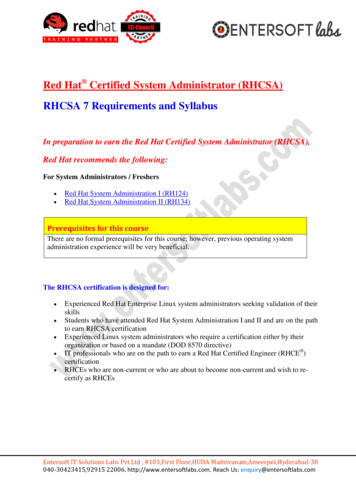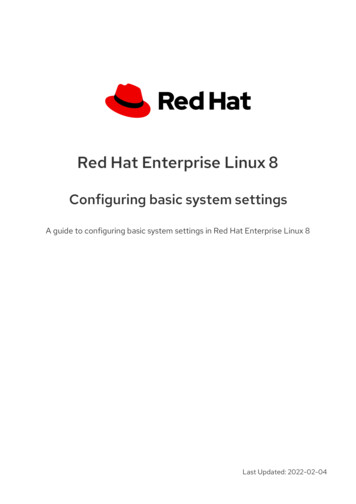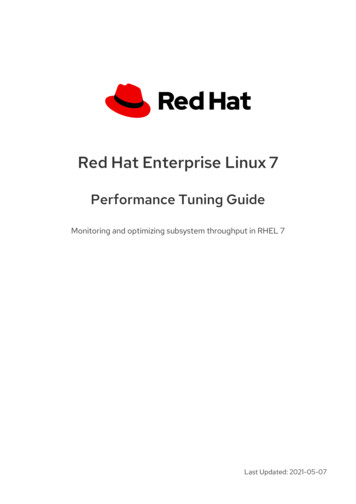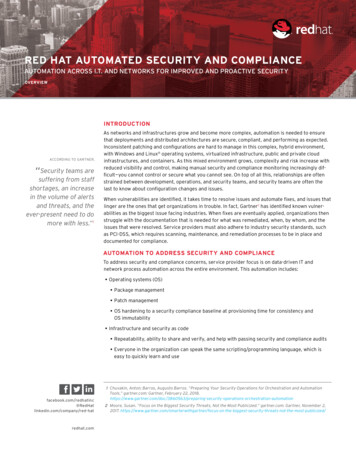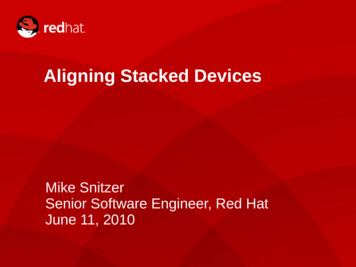
Transcription
Aligning Stacked DevicesMike SnitzerSenior Software Engineer, Red HatJune 11, 2010
I/O Limits – Quest for increased drive capacity 2Each sector on current 512 byte sector disks is quite a bit bigger than512 bytes because of fields used internally by the drive firmwareThe only way to increase capacity is to reduce overhead associatedwith each physical sector on diskTop: 8 x 512B sectors, each with overhead, needed to store 4KB ofuser dataBottom: 4KB sector drives can offer the same with much lessoverhead
I/O Limits – Transitioning to 4KB 4K sector drives may or may not accept unaligned IO If they do accept unaligned IO there will be a performance penalty Vendors will support a legacy OS with drives that have a 512Blogical blocksize (external) and 4K physical blocksize (internal) Misaligned requests will force drive to perform a read-modify-write Vendors working on techniques to mitigate the R-M-W in firmware 3R-M-W will cause a significant drop in performance: inducesincreased latency and lowers IOPSThere is quite a bit of inertia behind trying to preserve 512bsector support
I/O Limits – Alignment DOS partition tables default to putting the first partition on LBA 63Desktop-class 4KB drives can be formatted to compensate for DOSpartitioning sector 7 is the lowest aligned logical block, the 4KB sectors startat LBA -1, and consequently sector 63 is aligned on a 4KBboundaryLinux 2.6.31 allows partition tools, LVM2, etc to understand thatthis compensation is being used (alignment offset 3584 bytes),from:/sys/block/ DEVICE/alignment offset4
I/O Limits – Performance I/O hints Linux also provides the ability to train upper storage layersbased on hardware provided I/O hints Preferred I/O granularity for random I/Ominimum io size - the smallest request the device canperform w/o incurring a hard error or a read-modify-writepenalty (e.g. RAID chunk size)Optimal sustained I/O size optimal io size - the device's preferred unit of receivingI/O (e.g. RAID stripe width)Available through sysfs: /sys/block/ DEVICE/queue/minimum io size/sys/block/ DEVICE/queue/optimal io size5
Stacking I/O Limits – Overview All layers of the Linux I/O stack have been engineered topropagate the various I/O Limits up the stack.When a layer consumes an attribute or aggregates manydevices, it must expose appropriate I/O Limits so that upperlayer devices or tools will have an accurate view of the storageas it transformed.Examples: Only one layer in the I/O stack should adjust for a non-zeroalignment offsetonce a layer adjusts for it it will export a device with analignment offset of zeroA striped LVM logical volume must export a minimum io sizeand optimal io size that reflects chunk size and stripe count 6
Stacking I/O Limits – LVM LVM2 2.02.51 (2.02.62 saw last small related fix) Added devices/data alignment detection to lvm.conf Added devices/data alignment offset detection to lvm.conf 7Added --dataalignmentoffset to pvcreate to shift start ofaligned data area.LVM will read I/O Limits to determine the optimal start of thedata area (takes into account alignment offset,minimum io size and optimal io size) LVM defaults to creating a 64K aligned data area But I/O Limits support allows for additional precision DM uses LVM2 determined start when stacking limits
Stacking I/O Limits – Block layer and DM Block layer (Linux 2.6.31) has infrastructure to stack I/O limits physical block size, logical block size and minimum io size usemax() when stacking top and bottom device limitsoptimal io size uses lcm()DM now has infrastructure to detect if a combination of deviceswill lead to a misaligned DM device 8blk stack limits(top, bottom, start) verifies alignment and stacks{physical,logical} block size and {minimum,optimal} io sizeEach DM target implements an .iterate devices method thatcalls block layer's blk stack limits for each underlying device(during table load)The final stacked limits get assigned to the DM device'squeue when the DM device is resumed
Stacking I/O Limits – How it is made possible It all starts with the SCSI and ATA protocols Not all vendors' hardware will “just work”Linux now retrieves the alignment and I/O hints that a devicereportsLinux presents I/O Limits through uniform sysfs attributes for allblock devices. Ioctl interface is also available.DM, LVM2, cryptsetup have been updated to support I/O Limits 9The standards have been extended to allow devices toprovide alignment and I/O hints when queriedAlso Ext[234], XFS, libblkid, parted, fdisk, anaconda, virtio See: xt Thanks to Martin K. Petersen
10
4K sector drives may or may not accept unaligned IO If they do accept unaligned IO there will be a performance penalty Vendors will support a legacy OS with drives that have a 512B logical blocksize (external) and




